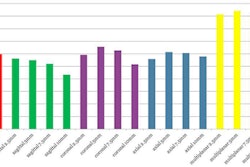
Today's lung cancer isn't your grandfather's squamous cell carcinoma. It is more likely an adenocarcinoma, with a spectrum of expression that can sometimes make growth appear sporadic or even nonexistent at CT. The new reality of lung cancer makes diagnosis and management more challenging than ever, and the radiologist must adapt accordingly, according to Dr. Jeffrey Galvin.
Standard follow-up criteria for CT-detected nodules can have the unintended effect of removing patients with progressing tumors from further follow-up, Galvin said. In many cases, only resection -- not biopsy -- can establish the diagnosis, and for many cancers, lesion architecture matters more than its size or growth rate.
 Dr. Jeffrey Galvin, professor of radiology and medicine at the University of Maryland.
Dr. Jeffrey Galvin, professor of radiology and medicine at the University of Maryland.
"Lung neoplasia may be unique in human neoplasia in that it is evolving," said Galvin, who is a professor of radiology and medicine at the University of Maryland. He also served as chief of chest and mediastinal imaging at the Armed Forces Institute of Pathology in Washington, DC, before the facility was closed.
"You and I were trained to believe that lung cancers grow at a certain consistent rate, and that we can decide what that rate is and decide when they can be biopsied and removed," Galvin said in a talk at the RSNA 2011 meeting. "The reality is that that's no longer true, and, if anything, we are now being asked to look at lung architecture" because these tumors don't necessarily grow and, in fact, often shrink for long periods of time.
Rare before tobacco
Lung cancer was rare enough to be a reportable case in the literature in the early 1900s, but as people began to use more tobacco, the number of cancer cases rose dramatically, Galvin said. But it wasn't until 1950, writing in the British Medical Journal, that Sir Richard Doll was able to connect the diagnoses to cigarette smoking, concluding that the risk of lung cancer may be 50 times as great among those who smoke 25 or more cigarettes a day as among nonsmokers. But most of those early cancers, caused by smoking unfiltered cigarettes, differ from those found today.
"Twenty-five years ago, when I was a pulmonologist, I saw large numbers of cancers that were squamous cell," Galvin said. "I don't see them anymore." By the 1970s, lung cancer diagnoses began to change fairly rapidly, "and we began to recognize that the lungs are external organs in that they're exposed to everything around you."
When the dangers of smoking became clear, manufacturers started putting filters on cigarettes, leading to smaller particles that smokers inhale more deeply. This resulted in cancers developing in the peripheral lung regions, he said. Today, environmental factors may be changing the diagnosis.
"I'm seeing cancers I have never seen before," Galvin said. "I'm also seeing cancers in women and men who are nonsmokers. About 300,000 of more than 1 million lung cancer deaths per year are nonsmokers." Nearly half of women diagnosed with lung cancer are nonsmokers. Approximately 80% of the cases are in Asia, 10% to 15% occur in the U.S., and about 10% of cases are in men.
Lung cancers are also appearing in different parts of the airway. Lung cancer traditionally appeared in mucosal and endocrine cells; only about 10% of adenocarcinomas originate in the bronchus, he said. But about 90% of adenocarcinomas begin in the alveoli, the so-called "terminal respiratory unit," Galvin said. Type I and type II alveolar cells are the source of these adenocarcinomas, though cigarette smoke involves both the airway and the alveoli.
"What we don't know is [what is causing] the 90% of adenocarcinomas that are not being caused by cigarette smoke," he said. But new evidence is beginning to shed light on this question as well.
Tailpipes and tumors
The automobile is gaining currency as a potential culprit, spewing from its tailpipe a steady stream of persistent free radicals attached to very small particles -- nanoparticles smaller than 2.5 microns. These particles can wield as much damage to lung tissue as a few cigarettes to a pack of cigarettes a day, depending on exposure, Galvin said.
One study found that every 10-mcg ambient increase in these nanoparticles corresponds to a 10% to 25% increase in adenocarcinomas, Galvin said. Another study found a geographic correspondence between automobile registration and lung adenocarcinoma (Cancer Epidemiology, Biomarkers & Prevention, March 2009, Vol. 18:3, pp. 760-764).
Lung cancers that originate in the alveolar walls can first be seen as atypical adenomatous hyperplasia (AAH); these are premalignant lesions that only pathologists can differentiate from cancer, if in fact they can do so reliably, Galvin said.
"All of us blithely talk about correlating our studies with what pathologists tell us, but you have to ask the pathologist how good they are at differentiating atypical disease from truly malignant to invasive tumors," he said. "If they cannot separate those with certainty, then our correlation means nothing."
To identify such a premalignant lesion, the pathologist looks for a circumscribed area -- generally 3 mm to 4 mm, but sometimes as large as 10 mm to 12 mm -- in a shape that is generally spherical and visualized on CT as tiny ground-glass nodules.
"Size won't help you," Galvin said. But "the more spherical they are, the more uniform they are, the more likely they are to be one of these premalignant lesions." The lesions tend to be multifocal, and like in most chronic inhalational diseases, they tend to appear in the upper lobes. Still, like any ground-glass nodule, they can represent infection or perhaps inflammation related to cigarette smoke alone, he said.
At the point where these abnormal regions progress from premalignant to malignant, the pathologist can see the premalignant cells starting to align themselves less uniformly -- piling on top of each other, pulling apart airways -- and the lesions often develop a dense central core, becoming less spherical. The name of these tumors has changed as well, Galvin added. What was once bronchoalveolar carcinoma (BAC) is now properly called adenocarcinoma in situ, according to the new multidisciplinary classification of lung adenocarcinoma (Journal of Thoracic Oncology, February 2011, Vol. 6:2, pp. 244-285).
"It is not the cells that the pathologist is looking at, it's their architectural behavior," Galvin said. "It's important because you have to give [pathologists] the whole lesion in order for them to decide if it's malignant or not. If you just give them a couple of cells they can't tell. What does that mean? There is no role, in my opinion, for biopsy. These lesions come out at the time you decide they need to come out."
Reasonable people might disagree with this assessment, but they're wrong, Galvin said. And if the cells themselves don't change a premalignant diagnosis to malignant, what's left is the architecture of the lesion, which the radiologist must try to discern in the CT images.
"Your job now is to look for architecture -- if you're looking for something that's growing, you'll never pick these up," he said. "The doubling times for these tumors are 800 to 1,500 days, so in three to four years they may not change at all and they may get smaller."
Finally, in invasive adenocarcinoma, the size of the scar is more important than lesion size, Galvin said. It's been shown that if the scar is smaller than 5 mm and the lesion is focal, the cure rate is 100%. The new more restrictive definition of bronchoalveolar carcinoma requires that there be no evidence of invasion, because if it's truly noninvasive then the cure rate is 100%, he said.
Inexact science
"Well-defined criteria are lacking for differentiating pure lepidic BAC from AAH ... there are few hard data to indicate exactly how much invasive growth is allowed ... before the lesion should simply be termed adenocarcinoma," (Kitamura et al, 1999) Galvin read from a discussion in the American Journal of Clinical Pathology.
Thus the disease process represents "a spectrum of change, and there are no lines that can be drawn," Galvin said. "The only time you see easy categorization is if one person reads the lesion. If you sit down with four or five of the most practiced pulmonary pathologists and show them these lesions, they will always argue about them, and it's OK."
In this setting, performing a biopsy and leaving the pathologist with only a few cells to work with "I believe is a disservice to the patient," he said. "You have to decide whether you're going to take it out."
As a radiologist, Galvin said that if he can't tell at CT whether a lesion is malignant or premalignant, "I think it's coming out."




















